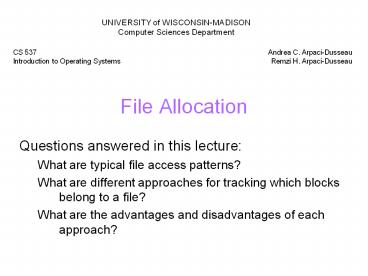File Allocation PowerPoint PPT Presentation
Title: File Allocation
1
File Allocation
UNIVERSITY of WISCONSIN-MADISONComputer Sciences
Department
CS 537Introduction to Operating Systems
Andrea C. Arpaci-DusseauRemzi H. Arpaci-Dusseau
- Questions answered in this lecture
- What are typical file access patterns?
- What are different approaches for tracking which
blocks belong to a file? - What are the advantages and disadvantages of each
approach?
2
Workloads
- Motivation Workloads influence design of file
system - File characteristics (measurements of UNIX and
NT) - Most files are small (about 8KB)
- Most of the disk is allocated to large files
- (90 of data is in 10 of files)
- Access patterns
- Sequential Data in file is read/written in order
- Most common access pattern
- Random (direct) Access block without referencing
predecessors - Difficult to optimize
- Access files in same directory together
- Spatial locality
- Access meta-data when access file
- Need meta-data to find data
3
Goals
- OS allocates LBNs (logical block numbers) to
meta-data, file data, and directory data - Workload items accessed together should be close
in LBN space - Implications
- Large files should be allocated sequentially
- Files in same directory should be allocated near
each other - Data should be allocated near its meta-data
- Meta-Data Where is it stored on disk?
- Embedded within each directory entry
- In data structure separate from directory entry
- Directory entry points to meta-data
4
Allocation Strategies
- Progression of different approaches
- Contiguous
- Extent-based
- Linked
- File-allocation Tables
- Indexed
- Multi-level Indexed
- Questions
- Amount of fragmentation (internal and external)?
- Ability to grow file over time?
- Seek cost for sequential accesses?
- Speed to find data blocks for random accesses?
- Wasted space for pointers to data blocks?
5
Contiguous Allocation
- Allocate each file to contiguous blocks on disk
- Meta-data Starting block and size of file
- OS allocates by finding sufficient free space
- Must predict future size of file Should space be
reserved? - Example IBM OS/360
- Advantages
- Little overhead for meta-data
- Excellent performance for sequential accesses
- Simple to calculate random addresses
- Drawbacks
- Horrible external fragmentation (Requires
periodic compaction) - May not be able to grow file without moving it
6
Extent-Based Allocation
- Allocate multiple contiguous regions (extents)
per file - Meta-data Small array (2-6) designating each
extent - Each entry starting block and size
D
A
A
A
B
B
B
B
C
C
C
B
B
D
D
- Improves contiguous allocation
- File can grow over time (until run out of
extents) - Helps with external fragmentation
- Advantages
- Limited overhead for meta-data
- Very good performance for sequential accesses
- Simple to calculate random addresses
- Disadvantages (Small number of extents)
- External fragmentation can still be a problem
- Not able to grow file when run out of extents
7
Linked Allocation
- Allocate linked-list of fixed-sized blocks
- Meta-data Location of first block of file
- Each block also contains pointer to next block
- Examples TOPS-10, Alto
- Advantages
- No external fragmentation
- Files can be easily grown, with no limit
- Disadvantages
- Cannot calculate random addresses w/o reading
previous blocks - Sequential bandwidth may not be good
- Try to allocate blocks of file contiguously for
best performance - Trade-off Block size (does not need to equal
sector size) - Larger --gt ??
- Smaller --gt ??
8
File-Allocation Table (FAT)
- Variation of Linked allocation
- Keep linked-list information for all files in
on-disk FAT table - Meta-data Location of first block of file
- And, FAT table itself
- Comparison to Linked Allocation
- Same basic advantages and disadvantages
- Disadvantage Read from two disk locations for
every data read - Optimization Cache FAT in main memory
- Advantage Greatly improves random accesses
9
Indexed Allocation
- Allocate fixed-sized blocks for each file
- Meta-data Fixed-sized array of block pointers
- Allocate space for ptrs at file creation time
D
A
A
A
B
B
B
B
C
C
C
B
B
D
D
D
D
B
- Advantages
- No external fragmentation
- Files can be easily grown, with no limit
- Supports random access
- Disadvantages
- Large overhead for meta-data
- Wastes space for unneeded pointers (most files
are small!)
10
Multi-Level Indexed Files
- Variation of Indexed Allocation
- Dynamically allocate hierarchy of pointers to
blocks as needed - Meta-data Small number of pointers allocated
statically - Additional pointers to blocks of pointers
- Examples UNIX FFS-based file systems
doubleindirect
indirect
indirect
tripleindirect
- Comparison to Indexed Allocation
- Advantage Does not waste space for unneeded
pointers - Still fast access for small files
- Can grow to what size??
- Disadvantage Need to read indirect blocks of
pointers to calculate addresses (extra disk read) - Keep indirect blocks cached in main memory

